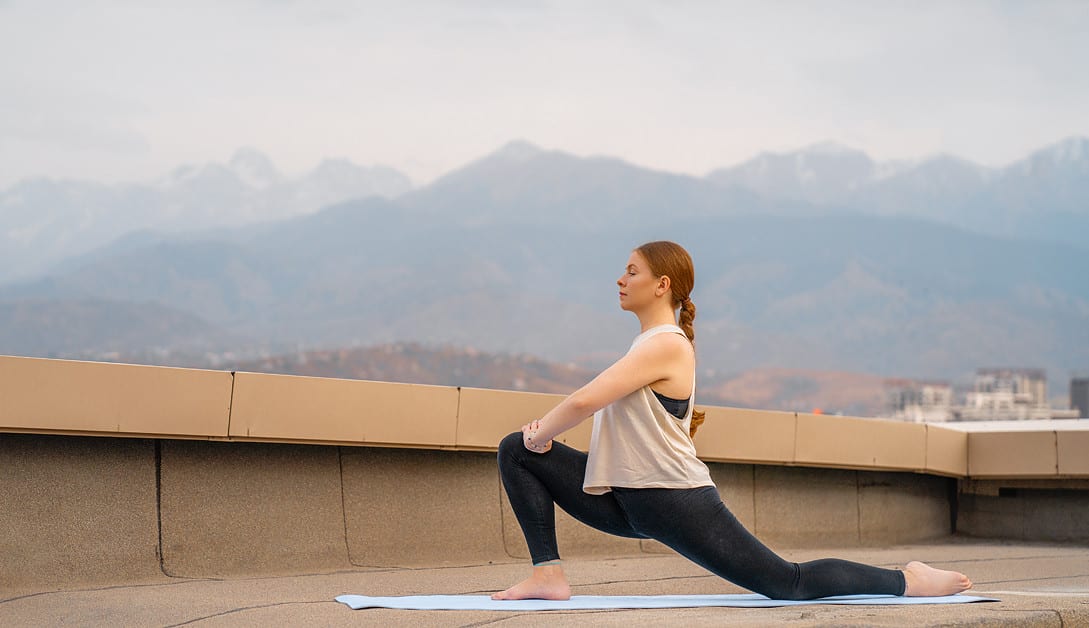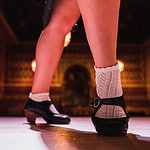Introduction
Osteoarthritis is the top form of arthritis. Sadly, the knees are one of the areas that can be affected. Yoga is a fine way to handle the pain and stiffness from osteoarthritis in the knees. Plus, your joint function can also be improved.
This overview will discuss the basics of yoga for osteoarthritis management. Additionally, we will provide some special yoga poses to reduce your pain and increase your joint function:
Definition of Osteoarthritis
Osteoarthritis is a serious, long-term condition. It’s caused by the breakdown of joint cartilage and the bones underneath. Symptoms include pain, stiffness and swelling. It’s the most common kind of arthritis, and it affects millions of people around the world.
It happens slowly over months or years. Cartilage helps the bones in the joints move smoothly. When it starts to break down, more pressure is put on the bones, causing pain in the joints. As it gets worse it can lead to disability. It usually affects the hands, feet, knees, hips, spine, shoulder blades, or neck.
Risk factors include:
- aging
- being female
- genetics
- being overweight
- having an injury
- having certain medical conditions like diabetes or rheumatoid arthritis
Treatments might include lifestyle changes, exercise, medication/injections, and surgery.
Benefits of Yoga for Osteoarthritis
Yoga can help ease Osteoarthritis (OA) symptoms and improve joint health. People with OA in their knees may suffer from pain, stiffness and movement issues. Practicing yoga can be beneficial. It is low-impact and includes poses that target and strengthen the joints. It increases flexibility and range of motion, reducing inflammation.
Yoga also encourages mindfulness and relaxation. This boosts confidence in tackling challenging movements and reduces pain. It strengthens psychological resilience towards chronic illness and improves overall quality of life.
Yoga Poses for Osteoarthritis in the Knees
Yoga is a great option for relieving pain from osteoarthritis in the knees! It increases range of motion, strength, and stability in the knee joint. Specific yoga poses help reduce knee pain and stiffness, improving knee function.
Here are some key poses to manage osteoarthritis in the knees:
Mountain Pose
Mountain Pose (Tadasana) is an easy and therapeutic pose. It stretches muscles, improves flexibility, strength and balance in the knee joints.
Start by standing with your feet together or hip-width apart. Ground your feet firmly into the earth. Lift your toes, spread them wide and ground them down again. Press down with the left three toes, while pressing out through the pinky toe on each side. Your pelvis should be neutral, tailbone pointing down, and hips level.
Engage your core muscles to keep your spine long and tall. Place your palms together at heart center. Extend energy up your arms and out through the fingertips. Relax your shoulders away from your ears. Be aware of gravity pulling downward.
Hold for 1–2 minutes per side. Then, exhale into Mountain Pose or another standing pose that builds strength in both knees for increased pain relief over time.
Chair Pose
Called Utkatasana in Sanskrit, Chair Pose is an excellent yoga posture for improving the strength and stability of the knee joint. Its benefit comes from strengthening the quadriceps and hamstrings, as well as all muscles around the knee joints. These muscles support the cartilage and bones in your knees.
To start, stand with feet flat on the floor hip-distance apart. Send your tailbone down, relax the lower back and engage your core to keep it long. Tuck the toes under if you can without pain. Activate with intention by lifting out of the heels. Bring arms straight up or praying hands together at chest-height. Keep chin drawn toward chest slightly to protect neck muscles and maintain a neutral spine.
Gently bend both knees at a 90-degree angle until you feel evenly distributed weight. Root through both feet by wiggling toes into floor. Apply evenly spread pressure through inner and outer arches. Move back to heel with intention while scooping lower belly up to remove any lower back strain. Hold the pose for 2 – 5 minutes per side.
Half Squat
Half Squat is a helpful yoga pose for knee osteoarthritis. It strengthens the muscles in the knee joint, improving balance and stability.
To start, stand with feet hip-width apart and arms down. Bend knees to lower into a gentle squat, until thighs are almost parallel. Use a wall or chair for support, if needed. Keep knees over big toe. Hold the pose for 20-30 seconds, breathing in through nose and out through mouth. To finish, rise up slowly. Squeeze gluteus muscles and press firmly with feet into the floor/wall.
Wide-Legged Forward Bend
Prasarita Padottanasana, or Wide-Legged Forward Bend, is great for Osteoarthritis in the knees. This pose stretches the hamstrings and brings mild traction to the knee joint. It helps improve range of motion and flexibility in the hips, legs, and ankles.
Start with feet four feet apart, toes pointing outward. If this is uncomfortable, bring feet closer together. Exhale and bend forward from hips, reaching for the ground with fingertips until a mild stretch is felt in the back of legs. Keep a natural curve in lower back and neck. Use blocks outside each foot if stretching further is difficult.
Hold pose 30 seconds to one minute, breathing deeply through nose. Coming out of pose, bend slightly at hips to protect lower back before straightening up. Relax with eyes closed for a few moments. Continue to practice other beneficial poses for Osteoarthritis in the knees if desired.
Hero Pose
Hero Pose, or Virasana, is great for those with knee osteoarthritis. It helps relieve pain and stiffness in the joints. It also exercises your quadriceps and hamstrings, strengthening muscles weakened by osteoarthritis.
To do Hero Pose, kneel down. Place cushions/blankets under your buttocks for support and comfort. Then, lower your hips towards the floor while keeping your knees together. Sit on the floor with your calves pressed against the back of your thighs and feet flat on either side. If this is uncomfortable, put a cushion between your calves and thighs. Place both hands gently over the tops of your knees, palms facing up/down.
Stay in this pose for at least two minutes. Don’t strain yourself. As you practice more, it will become natural and fluid.
Cow Face Pose
Cow Face Pose (Gomukhasana) is a seated yoga posture. It stretches and strengthens the hips, shoulders and neck. It provides relief for issues caused by osteoarthritis in the knees. These include stiffness, swelling, and limited range of motion. This makes activities such as walking and running easier.
To practice Cow Face Pose:
- Sit comfortably on the floor. Stretch your legs out. Bend your left leg and draw it up close to your right hip. Reach up with your left arm above your head. Try to look past your right ear. Reach behind you with your right arm. Aim for the inner left hip crease.
- Inhale and roll your shoulders back. Open your chest on each side. Exhale and draw down into each side of the body. Focus on the breath-driven movement. Repeat this sequence two more times.
Cow Face Pose increases flexibility in both hips. It strengthens surrounding muscles. It relieves pain associated with osteoarthritis in both legs. It creates physical, mental, emotional, and energetic balance. Move slowly and let your breath guide you. Find freedom from pain and balance from within.
Reclining Twist
The reclining twist can stretch and relax muscles around the knee joint. It can also improve mobility and circulation in the area. This pose helps keep hips and trunk flexible. It targets pressure points deep within the knee joints.
- Lie close to a wall or doorway for comfort. Extend legs straight out in front, and cross one leg over the other at a 90-degree angle. Put the outer side of your foot on the floor.
- Place one hand on the lower abdomen. Reach up with the other arm and grab the top knee. Gently guide it across towards that side. Bring shoulder blades off the floor as far as comfortable.
- Take deep breaths and hold for 3 minutes. Sink deeper into the pose with each exhale.
- Release slowly by releasing one hand at a time. Return to centre and repeat on the opposite side.
Safety Tips
Yoga – a great therapy to soothe osteoarthritis in the knees! But, caution must be taken when performing poses. To gain the most out of this exercise, certain safety measures should be followed. Ensure you practice safely and correctly!
Listen to your body
Everyone is different, and different bodies react to poses differently. Listen to your body and adjust poses as needed. When practicing yoga, be aware of your limitations and don’t push yourself past what feels comfortable. If pain occurs, stop and adjust. Before attempting a new pose, define what you can do safely. Increase difficulty slowly, breaking down poses step by step.
Yoga is not a competition. It’s a personal journey with unique benefits. Mindful movement can reduce stress, calm anxious thoughts, and create space for reflection. Experienced yogis often say it’s important to pay attention to your physical body and inner being through meditation and self-reflection.
Move slowly and mindfully
Be mindful when going around your work area. Go slowly. This helps you stay aware of your environment and those around you, stops injuries. Wear safety gear like glasses, a hard hat, steel-toed boots. Give yourself time to avoid hazards. Read signs and do safety protocols before starting work.
Use the buddy system if working with hazardous materials or conditions. There’s then help if needed.
Use props to support your body
Maintaining safety in yoga is key. Props such as blocks, straps, bolsters, and blankets are a great way to support your body. Props can give you traction, extra support, and allow long holds. This can help you move into poses safely, especially if they’re new.
Props can prevent strain or injury, reduce fatigue, and provide extra stability and balance. They also enable better alignment throughout postures, as they provide stability and release points, as well as less direct tension on muscles and joints.
Stop if you feel any pain
Listen to your body and take it slow. This is especially true with yoga for osteoarthritis in the knees. Yoga postures can help, but can hurt if done too intensely or without proper form. Stop if you feel pain or discomfort. Experiment with modifications.
- Begin by warming up with gentle movements.
- Use props like blankets, blocks, or straps.
- Come out of poses slowly and intentionally.
- Visualize pouring soft light energy on joints for extra relaxation.
Conclusion
Yoga: A remedy for knee osteoarthritis. Diminish knee soreness, increase flexibility and mobility, and enhance joint functionality and coordination! Introducing yoga to your daily routine is an incredible way to alleviate the discomfort and rigidity of this condition, and better your quality of life.
Summary of Benefits
Yoga can be hugely beneficial for those with knee osteoarthritis. It can:
- Reduce pain intensity and stiffness
- Increase physical functioning and overall quality of life
- Improve muscle strength and flexibility in the knees
- Increase balance and control of movements
- Promote relaxation and mindfulness
- Cultivate healthy breathing habits
- Help manage depression and anxiety
- Address postural problems associated with knee osteoarthritis
Plus, yoga is a low-impact form of exercise, making it a great choice for joint protection while working towards fitness goals. People have found great relief from their knee arthritis symptoms through specialized poses. However, always consult a healthcare professional before starting yoga – modifications may be necessary depending on your needs or limitations.
Takeaways
Yoga can be an aid for those suffering from osteoarthritis in the knees. Poses can help reduce pain and improve function. It should be used in addition to other treatments, such as medication and physical therapy.
Targeted poses can improve flexibility, range of motion, strength and relaxation. When starting out, limit movements to what is comfortable. Then, progress deeper into poses as your body gets more accustomed to them.
The takeaway is this: yoga can be a helpful complementary therapy for those with OA knee pain. It can reduce aches and pains, and increase flexibility, range of motion and strength. Begin slowly and progress when ready.
Frequently Asked Questions
Q: What type of yoga is best for osteoarthritis in the knees?
A: Gentle, low-impact yoga poses are the best option for people with osteoarthritis in the knees, as they are less likely to cause further strain on the joints.
Q: What are the benefits of yoga for osteoarthritis in the knees?
A: Yoga can help to improve knee function, reduce joint pain and stiffness, and improve balance and posture. It can also help to reduce stress and anxiety, which can help to lessen the pain associated with osteoarthritis.
Q: How often should I practice yoga for osteoarthritis in the knees?
A: It’s best to practice yoga for osteoarthritis in the knees at least three times a week for the best results. It’s important to listen to your body and take breaks when needed.





